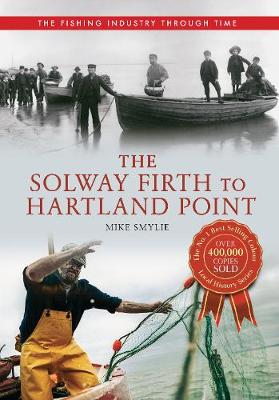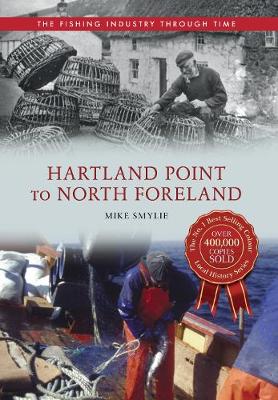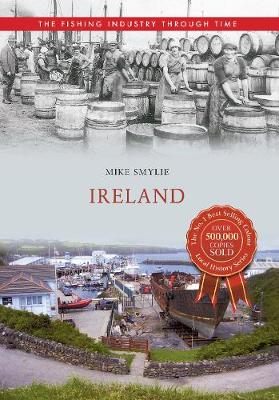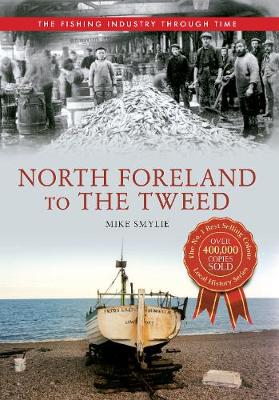The Fishing Industry Through Time
6 total works
The Solway Firth to Hartland Point The Fishing Industry Through Time
by Mike Smylie
Published 15 February 2014
The fishing industry has always been important to Britain. From the deepsea trawlers to the traditional craft that sailed around the coast, the harbours of the West Coast, Irish Sea and Bristol Channel were once full of craft, large and small, which employed men and women in their thousands. The third volume of Mike Smylie's Fishing Industry Through Time covers from the Solway Firth all the way to Hartland Point in Devon. Fishing was not just about the boats involved but also the people and Mike Smylie gives an insight into the lives of those who worked the boats, who repaired the nets and who gutted and sold the fish. From the mighty trawling port of Fleetwood to salmon fishing on the River Dee, from herring to prawns and cockles, he gives us a rare insight into an almost-lost industry that once employed huge numbers.
The Tweed to the Northern Isles The Fishing Industry Through Time
by Mike Smylie
Published 15 June 2013
Since Britain joined the European Economic Community in the mid-1970s, the fishing industry along our coasts has been under pressure from overfishing. In this book, Mike Smylie takes us on a tour from the Tweed to the Northern Isles, taking us to harbours that you could once walk over on the hundreds of fishing boats to coastal inlets where the herring once shoaled. We also see the fishermen and women on shore and at sea, their boats, the harbours and the methods used to catch the fish.
Many of the smaller fishing villages on Scotland's east coast are now tourist hotspots, with the industry concentrated in ports such as Eyemouth, Peterhead, Fraserburgh and Lerwick and Mike Smylie shows the industry's decline and its resurgence in those centres today. From the quaint fishing villages of Fife to the abandoned herring stations of Orkney and Shetland, the industry is illustrated by the contrast between these old and new images.
Many of the smaller fishing villages on Scotland's east coast are now tourist hotspots, with the industry concentrated in ports such as Eyemouth, Peterhead, Fraserburgh and Lerwick and Mike Smylie shows the industry's decline and its resurgence in those centres today. From the quaint fishing villages of Fife to the abandoned herring stations of Orkney and Shetland, the industry is illustrated by the contrast between these old and new images.
From Duncansby Head to the Solway Firth: The Fishing Industry Through Time
by Mike Smylie
Published 15 September 2013
Since Britain joined the European Economic Community in the mid- 1970s, the fishing industry along our coasts has been under pressure from overfishing. In this book, Mike Smylie takes us on a tour from Duncansby Head to the Solway Firth. Here, small crofting communities sit on the fringe of the sea, hidden among the lochs and islands that indent Scotland's beautiful west coast and using what may well be the prettiest fishing boats in Britain. Although fishing here was mostly subsistence level and did not approach the scale of the industry on the east coast, there were large harbours at Stornoway, Castle Bay on Barra, Ullapool, Mallaig, Tarbet and Campbeltown. Mike Smylie shows us harbours, large and small, along with the boats and the communities that depended on them, from the herring fishery of Stornoway to salmon netting on the Solway Firth.
Hartland Point to North Foreland The Fishing Industry Through Time
by Mike Smylie
Published 15 June 2014
Since Britain joined the European Economic Community in the mid-1970s, the fishing industry along our coasts has been under pressure from overfishing. Mike Smylie takes us on a tour of England's south coast, taking us to harbours that you could once walk over on the hundreds of fishing boats to coastal inlets where the herring once shoaled. Each area of the coast had its unique boats, built for local conditions, as well as methods of catching the fish.
Mike Smylie, shows us the fishermen and women on shore and at sea, their boats, the harbours and tells us of the methods used to catch the fish. He also documents the changes and the decline of the industry, from the times when it once employed hundreds of thousands. Covering the South Coast and English Channel, Mike Smylie brings the pilchard and herring industries to life, as well as looking at the unique fishing boats to be found in Kent and Sussex.
Mike Smylie, shows us the fishermen and women on shore and at sea, their boats, the harbours and tells us of the methods used to catch the fish. He also documents the changes and the decline of the industry, from the times when it once employed hundreds of thousands. Covering the South Coast and English Channel, Mike Smylie brings the pilchard and herring industries to life, as well as looking at the unique fishing boats to be found in Kent and Sussex.
The fishing industry has always played an important part in Ireland's history. From the deep-sea trawlers to the traditional vessels that sailed around the coast, the harbours of Ireland were once full of craft, large and small, that employed men and women in their thousands. Since Ireland's entry into the European Economic Community, it has lost control over its rich territorial waters, and we are now instead seeing Spanish and Portuguese boats fish off the coast.
The sixth volume of Mike Smylie's Fishing Industry Through Time covers the Irish coast. From the ports of the Irish Sea to the Atlantic coast of the west of Ireland, Mike Smylie shows us the changing types of traditional fishing craft used in Ireland. Fishing was not just about the boats involved, however, but also about the people, and this book gives an insight into those who worked the boats, repaired the nets, and gutted and sold the fish.
The sixth volume of Mike Smylie's Fishing Industry Through Time covers the Irish coast. From the ports of the Irish Sea to the Atlantic coast of the west of Ireland, Mike Smylie shows us the changing types of traditional fishing craft used in Ireland. Fishing was not just about the boats involved, however, but also about the people, and this book gives an insight into those who worked the boats, repaired the nets, and gutted and sold the fish.
North Foreland to The Tweed The Fishing Industry Through Time
by Mike Smylie
Published 15 October 2014
Since Britain joined the European Economic Community in the mid-1970s, the fishing industry along our coasts has been under pressure from overfishing. Mike Smylie takes us on a tour of England's North Sea coast, taking the reader to harbours that you could once walk over on the hundreds of fishing boats, and to east coast beaches and rivers that boasted their own fishing fleets.
Each area of the coast had its unique boats, built for local conditions, as well as methods of catching the fish. From North Foreland on Kent's Isle of Thanet to the River Tweed, Mike Smylie shows us the fishermen and women on shore and at sea, their boats, and the harbours, and tells us of the methods used to catch fish. He also documents the changes in and decline of the industry, from the times when it employed hundreds of thousands of working people.
Each area of the coast had its unique boats, built for local conditions, as well as methods of catching the fish. From North Foreland on Kent's Isle of Thanet to the River Tweed, Mike Smylie shows us the fishermen and women on shore and at sea, their boats, and the harbours, and tells us of the methods used to catch fish. He also documents the changes in and decline of the industry, from the times when it employed hundreds of thousands of working people.





